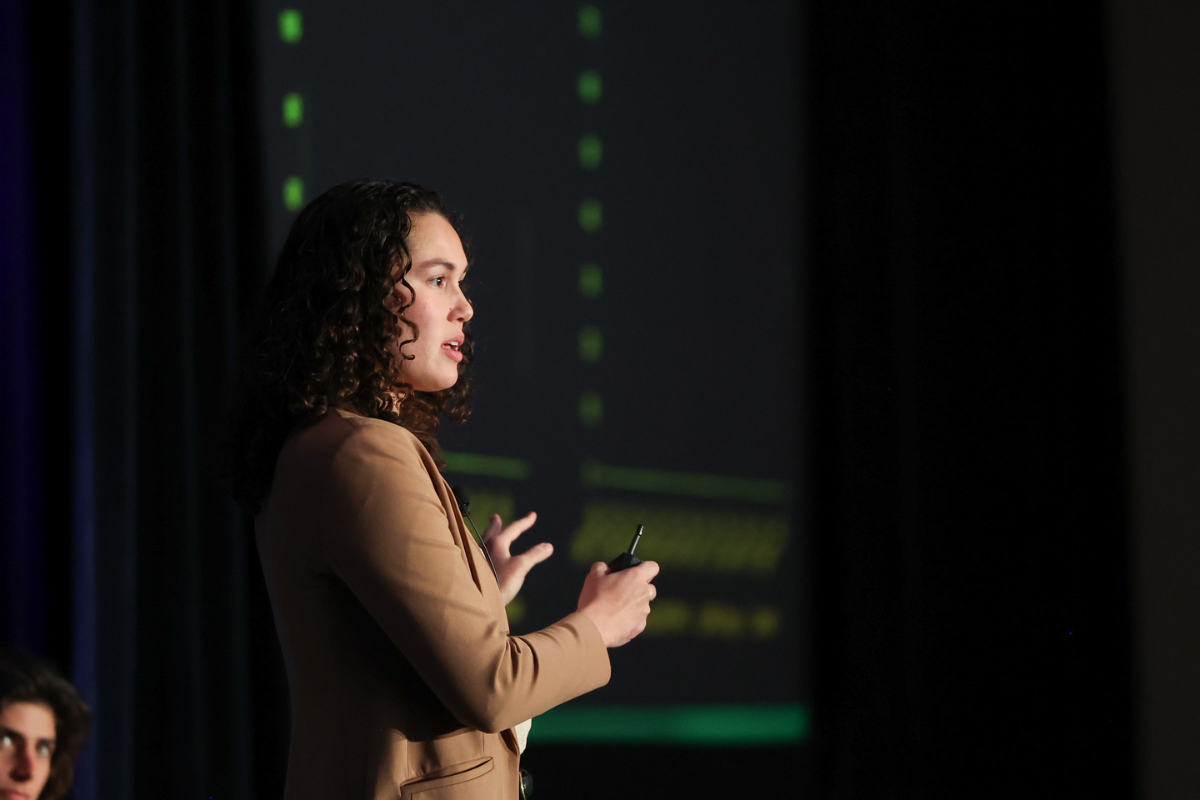
Emily Friedman of ICIS described several trends driving recycled resin markets in the U.S., during the 2024 Plastics Recycling Conference in Grapevine, Texas. | Big Wave Productions/Plastics Recycling Update
A long runup in recycled natural HDPE prices came to an end last summer, when prices plummeted to levels not seen since 2019. A market analyst with ICIS recently explained how this has become a trend in the plastics recycling market – and how the cycle is beginning again.
Emily Friedman, recycled plastics senior editor at ICIS, spoke about the market trend during “Insight From the Analysts,” a session at the 2024 Plastics Recycling Conference in Grapevine, Texas in March. She spoke alongside Andrea Bassetti, recycled plastics senior analyst at ICIS, who presented on chemical recycling markets. The session was moderated by Dan Holtmeyer, managing editor of Resource Recycling, Inc.
HDPE example shows recycled premium ceiling
Friedman gave a rundown of how recycled resin pricing has evolved over time, noting that recycled material historically was used as a cheaper alternative to virgin or wide-spec resin. “Wide-spec” refers to virgin material that does not meet specifications for prime plastic and is sold as a cheaper feedstock.
Friedman said post-industrial or mixed-color recycled resin pricing still battles with wide-spec and virgin, but that the pricing dynamic for other grades is changing, in part because of brand owner demand. These materials, which Friedman called “sustainability-driven recycled resins,” are the post-consumer, typically clear, resins.
Rather than being tied directly to the virgin market, the pricing equation for this PCR is based on the feedstock cost, Friedman added. So, PCR prices reflect plastic bale prices and the cost to process the material.
“Oftentimes from feedstock through production, the washing, the grinding, the extruding, that’s going to put your price higher than what we see in crude-based or natgas-based virgin plastic,” Friedman said.
But that creates pressure on the recycling sector, because there are limits on how much of a premium recycled resin producers can charge and have the market bear it.
“At the end of the day, the converter, the brand company and then us as consumers aren’t willing to uphold that,” Friedman said.
That came to a head recently with recycled HDPE prices: At its height in the summer of 2023, post-consumer natural HDPE was selling for nearly double what virgin HDPE cost. The recycled resin was trading for 120 cents per pound, compared to about 60 cents per pound for virgin resin, according to ICIS data.
“At that point, we saw a significant withdrawal of demand, which then caused pricing to crash, so that premium came down to more historic levels,” Friedman said.
Recycled HDPE bale prices followed suit: Natural HDPE bales fell from about 75 cents per pound in May 2023 down to 23 cents per pound in August, according to RecyclingMarkets.net pricing reports.
This pricing dynamic has become something of a cyclic trend, Friedman said: As demand rises for recycled resin, prices increase alongside it, until they reach a point where the premium is unsustainable. Then, “the market crashes and we start back over again.”
The trend is particularly visible in the recycled natural HDPE space, where collection is steady – “We’re not drinking any more milk than we were 10 years ago,” Friedman said, meaning the supply from products like recycled milk jugs is fairly tight – and yet the resulting clear recycled resin is in growing demand from brand owners.
She added that after the recycled HDPE price crash last fall, there are signs of the cycle beginning again.
“We’re kind of in the rebuilding phase of this market,” Friedman said. “Do I expect supply will remain tight? Yes. Do I expect demand will continue to increase? Yes. So I think we’re on track to continue that cyclic pattern.”
As one indicator of that cycle beginning again, natural HDPE bale prices have been slowly creeping up since last fall and reached nearly 31 cents per pound last month.
PET imports add new pressure
Friedman also touched on a major trend in the PET space: Plastics recycling companies are facing rising competition from imports of recycled plastic, which play into the prices domestic reclaimers can charge.
“We are really feeling that here in the U.S. market, particularly in the PET space,” Friedman said. Recovered PET imports into the U.S. shot up 33% last year, highlighting how plastics recycling has become a global industry, Friedman added.
The imported material, which can be in the form of bottles, flake or pellets, is cost-competitive with U.S.-generated recycled plastic, she added. Overseas recycling operations sometimes have lower labor costs, and with freight rates trending downward, imported scrap can even go for lower than U.S. material.
“So now not only do recycled resin prices need to compete with virgin counterparts to some degree, you also need to be looking at import competition as well,” Friedman said.
The PET imports in 2023 came predominantly from Asia, but volumes also came from Latin America and Africa. And Friedman hinted that Europe could become another competitor.
“I do hear in conversation that players in Europe are looking, is there opportunity in the U.S.,” she said. “If European markets are weaker, can we send it here to the U.S.?”
PET imports have hit particularly hard in California, where reclaimers are pushing for financial assistance from the California Department of Resources, Recycling and Recovery, or CalRecycle, the state’s recycling agency, to offset the impact to PET processors and to better incentivize manufacturers to use domestically-sourced RPET.
Reclaimers in California are facing additional pressure buying bales, because reclaimers in Mexico are increasingly competing to buy California bales, driving up the bale prices.
“Right now, they’re caught between a rock and a hard place,” Friedman said of plastics processors in California.

